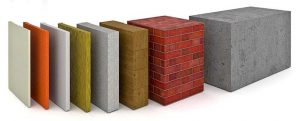Thermal conductivity of materials for construction, main indicators
It’s no secret that each material has its own exceptional qualities. One of these is thermal conductivity.
Let’s look at an example of what the wall thickness of different materials should be in the room to ensure a habitable temperature of 18 degrees Celsius, when the frost outside is -26 degrees.
If you build from hollow bricks, you will have to build a wall 51 centimeters thick, from expanded clay concrete – 30 centimeters, a wall made of wood may not exceed 15 cm, and concrete with the use of insulation can barely reach 14 cm at all. Why is this so? Each of these materials has its own thermal conductivity.
As we can see, it is very important to decide on the project at the initial stages of construction, so as not to get into a mess. The more accurate the data, the higher the probability of a high-quality calculation and selection of building materials. To determine the raw material and not be mistaken – use the data below. Equivalent thermal conductivity of building materials:

- polyurethane foam – 80
- expanded polystyrene – 160
- mineral wool – 200
- tree – 548
- expanded clay – 640
- aerated concrete – 800
- brick – 1520
- granite – 2500
- concrete – 3440
……………
Read more in Russsian




